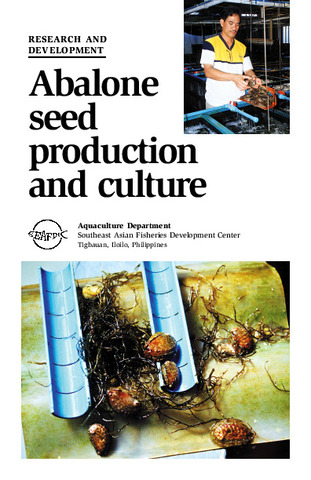Evaluation of post-release behavior, recapture, and growth rates of hatchery-reared abalone Haliotis asinina released in Sagay Marine Reserve, Philippines
- Global styles
- MLA
- Vancouver
- Elsevier - Harvard
- APA
- Help

View/
Date
2013Author
Page views
4,320ASFA keyword
AGROVOC keyword
Metadata
Show full item recordCited times in Scopus
Share
Abstract
The lucrative returns brought by abalone fisheries have caused overexploitation and decline of the wild population. In the Philippines, the Aquaculture Department of the Southeast Asian Fisheries Development Center has successfully produced Haliotis asinina seeds in the hatchery. Aside from utilizing these seeds in aquaculture, they are also being considered for future stock enhancement endeavors of the department. This study aimed to evaluate post release behavior, recapture and growth rates of hatchery-reared abalone juveniles released in the Sagay Marine Reserve. From the two release trials conducted, results showed that abalone of shell length >3.0 cm had lower mortality during onsite acclimation and utilized transport modules as temporary shelter for a shorter period after release. Both wild and hatchery-reared abalone preferred dead branching corals with encrusting algae as their habitat. Recapture rates were comparable between the wild (7.97%) and hatchery-reared (HR2) abalone (6.47%). Monthly growth rates were almost the same between wild (0.25 cm, 4.0 g), hatchery-reared (HR1: 0.27 cm, 4.6 g; HR2: 0.35 cm, 3.8 g) abalone. Moreover, hatchery-reared abalone were recaptured up to 513 days post-release, indicating viability of released stocks in the wild. Results of releases revealed that hatchery-reared abalone can grow and survive with their wild conspecifics.
Suggested Citation
Lebata-Ramos, M. J. H., Doyola-Solis, E. F. C., Abrogueña, J. B. R., Ogata, H., Sumbing, J. G., & Sibonga, R. (2013). Evaluation of post-release behavior, recapture, and growth rates of hatchery-reared abalone Haliotis asinina released in Sagay Marine Reserve, Philippines. Reviews in Fisheries Science , 21(3-4), 433-440. https://doi.org/10.1080/10641262.2013.836445
Type
ArticleISSN
1064-1262; 1547-6553Collections
- Journal Articles [1229]
Related items
Showing items related by title, author, creator and subject.
-
Evolution of genome size within the genus Haliotis (Vetigastropoda: Haliotidae)
Adachi, Kenta; Arai, Katsutoshi; de la Peña, Milagros R.; Moriyama, Shunsuke; Okumura, Sei-Ichi (National Shellfisheries Association, 2018)Genome size (C-value) and the percentage of adenine and thymine nucleotides in the genome (AT content) are fundamental characteristics of every species, and very important parameters in molecular cytogenetic and phylogenic ... -
Abalone seed production and culture
Unknown author (Aquaculture Department, Southeast Asian Fisheries Development Center, 2000)Details the research conducted at AQD for the tropical abalone Haliotis asinina. AQD has developed the rudiments of a hatchery protocol. -
Evaluation of density and cage design for the nursery and grow-out of the tropical abalone Haliotis asinina Linne 1758
Encena II, Vincent C.; de la Peña, Milagros; Balinas, Vicente T. (National Shellfisheries Association, 2013)The effect of stocking density and cage design on the growth, survival rate, and feed conversion ratio was evaluated for the nursery (11–15 mm in shell length) and juvenile grow-out (26–30 mm in shell length) of the tropical ...





